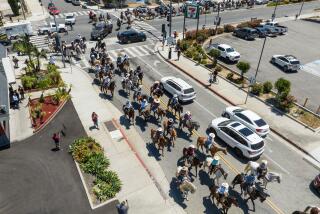Youngsters Put Livestock Up for Fair Price
- Share via
First came months of feeding and grooming, then the judging the past few days at the Ventura County Fair, and finally, on Friday, the big event.
The Junior Livestock Auction drew more than 400 nervous youths, all dressed in spotless white 4-H and Future Farmers of America uniforms, showing off cows, pigs, chickens, sheep and goats, and hoping to get top dollar.
Once sold, the next stop for many of the animals will be the slaughterhouse. Some will be used for breeding, but either way, Friday was one of the last days the youths had with the animals they spent months caring for.
But there was little sentimentality Friday. The 9- to 17-year-olds were focused on the frenzied, clamorous auction held inside the fair’s Clark Pavilion, where a crush of buyers and supporters in Stetsons and cowboy boots rooted for their favorite young farmers.
“This is a high social event,” said Craig Fosdick, the fair’s livestock superintendent.
Raising an animal and selling it is not just educational, but also a way to tuck money away for college for many of the youths. Some will use their earnings to buy another animal for next year.
On Friday, a continuous string of owners and their mooing, snorting livestock poured through the arena, as the auctioneer’s patter rang out the loudspeakers. The youths stepped gingerly over cow pies with concentrated poise, while proud parents with camcorders followed every move.
“We have a supportive group here, why be nervous?” laughed Rachel Lovelace, 15, of Piru, who sold her massive Grand Champion steer, Hearty, for $11 a pound, or more than $13,000, Friday’s top price.
The steer was bought by a group that included her grandmother, Betty Bishop, family friend Beverly Bigger, and members of the Ventura County Cattlemen’s Assn., who all pooled their money to buy the animal.
Prospective buyers often combine resources, Bishop said, to give them more money to bid with. Many buyers said the main reason they come is to support the young farmers.
“Anything to support” them, said Bigger.
During the past few weeks, many prospective buyers received letters from hopeful youths asking them to consider buying their animal.
Fosdick said standard procedure for the clubs is take lists of who bought animals at the previous year’s auction and send the buyers letters--and perhaps flowers, hats or photographs--the following year.
“I’ve had buyers come to me and show me a letter scrawled in crayon saying, ‘Please, will you buy my pig?’ ” Fosdick said. “And the buyers go nuts over those things. They’ll come out and spend hundreds of dollars on an animal.”
Many buyers donate the butchered meat to FOOD Share, the county’s largest food bank, which provides groceries to about 30,000 low-income people each month.
Some buyers, while there to support the youths, don’t mind getting caught up in the excitement.
“We start having fun and we start bidding and pretty soon we have more cows than we know what to do with,” said Jody Cromer, who ranches cattle in Ojai. She and a friend received rousing applause for paying $2,100 for a heifer raised by Ian Hayward of Moorpark.
Even ribbon-winning cows that went for less money drew plenty of bids and attention. Nicole Couch, 15, of Fillmore, sold her Charlois shorthair heifer, Blondie, for $1.25 a pound, or about $1,000.
Blondie will go to a ranch and be used for breeding.
“She’s spoiled, but she’s a really good cow,” Nicole said. “It’s really tough because you get attached to them.”
Elsewhere, fair-goers continued to take in hundreds of exhibits and to munch on favorite junk foods as the 12-day event counted down to its Sunday close.
By Thursday, 169,532 people had attended the fair, down 13% from last year.
More to Read
Sign up for Essential California
The most important California stories and recommendations in your inbox every morning.
You may occasionally receive promotional content from the Los Angeles Times.













